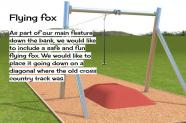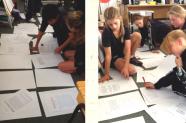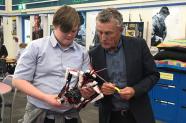Technology and values
We are preparing to close this site soon as this content has now moved to Tāhūrangi.
Tāhūrangi is the new online curriculum hub for Te Tāhuhu o te Mātauranga | Ministry of Education.
Values are described in The New Zealand Curriculum as "deeply held beliefs about what is important or desirable. They are expressed in the ways that people think and act".
The curriculum expects that all schools will encourage students to value:
- excellence
- innovation, enquiry, and curiosity
- diversity
- equity
- community and participation for the common good
- ecological sustainability, including care for the environment
- integrity
- respect for themselves, others, and human rights.
Along with other teachers, teachers of technology are encouraged to develop learning experiences that provide students with opportunities to learn about values and develop value-related capabilities.
Learning about values refers to students learning about:
- their own and others' values
- different kinds of values such as moral, social, cultural, aesthetic, and economic values
- those values upon which New Zealand's cultural and institutional traditions are based.
Developing value-related capabilities refers to students developing the ability to:
- express their own values
- explore the values of others
- critically analyse values and actions based on them
- discuss disagreements that arise from differences in values, and negotiate solutions
- make ethical decisions and act on them.
Technology and values education
Developing broad technological knowledge, practices, and dispositions is values-laden and values-dependent. Every technological outcome arises out of a social context, influenced by the values of the day and influencing the values of the future. So technological learning provides authentic contexts for students to consider their own values and to examine those of others.
The following sections, organised by curriculum strand, illustrate some of the ways in which values can be embedded in technology learning.
Values in the Technological Practice strand
Brief development
When trying to identify an authentic need or opportunity or develop a brief, students need to comprehensively explore and critically analyse the context, associated issues, and stakeholder wants and wishes. These factors will be strongly influenced by societal and stakeholder values.
When defining specifications, students need to understand these values to ensure that fitness for purpose is established in its broadest sense. This means that stakeholder values need to be analysed and compared and areas of disagreement identified and resolved. Only then can a brief be developed that is acceptable to the key stakeholders and to those who could be impacted indirectly or in the future.

Primary playground redesign
Students thoroughly investigated playgrounds to work out which attributes were important to students at their school.

STEELBRO Bluetooth application
Student Parker communicated extensively with the CEO of STEELBRO, marketing staff, his father an engineer at STEELBRO, and the equipment operators to develop an acceptable brief for his application.
Planning for practice
As part of planning for practice, students need to learn to care for the environment, manage resources efficiently, and make ethical decisions that contribute to sustainable development.
Ongoing reflection and evaluation of past practice are critical. This requires that they explore their own and others’ values, and how these values impact on decision making. To work effectively, ethically, and responsively, specific planning mechanisms need to be in place throughout developmental work.

Technological practice and producing a newspaper
The students began this unit looking at newspaper articles about culture and discrimination integrating with their health unit. The students collected their own stories and worked together to critique stories and decide the order of the stories for the paper.

Values: Halo project
Students planned out a multi-unit manufacturing process to help tieke thrive in their community.
Outcome development and evaluation
In this component there is an emphasis on achieving excellence and persevering to produce a worthwhile outcome.
Not all technological practice results in a technological outcome. Technological practice can also lead to creative and innovative ideas being taken to various points that stop short of full realisation. It is entirely acceptable to arrive at a no-go decision when there is no defensible reason to use resources for the purpose originally intended.
When selecting outcomes for further development, students should be fully considering and critically analysing what is of value and why. They should be weighing the functional and aesthetic value of materials against their environmental cost, interrogating designs and resourcing before selecting materials, and proceeding to the development of a final outcome. By doing so, they develop the ability to make ethical decisions and act on them.
Also, students should critically evaluate outcomes and the practice by which they are developed from multiple perspectives to ensure their fitness for purpose. When considering stakeholder responses they should try to understand these in terms of the values embedded in them. When justifying their own decisions they should identify and articulate their own values and explain how these are (or are not) shared by other social groups.

Kawakawa leaf extract
In student Chris' project, it was essential to engage with rongoā/medicine in a way that was respectful. Chris spoke at length to the people of Ngā Pae o te Māramatanga about practices and fitness for purpose of his outcome.

Captivating contexts: Kiwi break
This context gave students a broad framework and an opportunity to consider what they and others valued in their summer breaks.
Values in the Nature of Technology strand
Characteristics of technology
Analysing the history of technological development can give students insight into how people’s values and "institutionalised" values have influenced technological decision making and impacted in turn on the values of others. They may like to consider examples of companies that have deliberately set out to develop products that embody specific environmental values and, possibly, influence the values of others.
Students can also engage in informed debate of contentious issues concerned with technology and unpack the complex moral and ethical issues that usually inhabit any particular position. Past technological developments can be explored in terms of how they addressed or ignored diversity, equity, and respect for others. This can help students to more easily identify the importance of these issues today. Numerous examples can be found, past and current, of clashes between indigenous people and colonising forces, where the latter’s technologies have ensured their dominance. A result of such victories is the devaluing of indigenous knowledge and customs, particularly with regard to imposed technologies. For New Zealand examples and understanding, senior students could explore the Waitangi Tribunal’s WAI 262 report.
Technological developments in medicine can be explored for the complex ways in which different people's religious, cultural, and environmental values interact, with negative outcomes for some groups. Students could consider a more consultative and informed approach, in which alternative views and values are afforded respect.

Astronomy and e-textiles
Students considered light pollution issues and how light as a technology had impacted on the social and natural world over time.
"Defending the Dark", Connected, Level 4: This is a useful resource for this context.
Characteristics of technological outcomes
Under the umbrella of this component, students can examine the fitness for purpose of past technological outcomes and make informed predictions about future technological directions. To interpret technological outcomes they must identify their purpose and the values that underpinned their development. By exploring examples of historical, contemporary, and possible future technological outcomes they learn that what is considered "fit for purpose" varies across people, places, and time. They also learn to critically review the fitness of any purpose and how this may change as the values of designers and users evolve over time.

Using tāniko to introduce design
Students explored the societal and environmental issues that influenced early Māori when they made clothing and the knowledge that is important to Māori weavers today.

"Fake Facts", Connected, Level 4: This is a useful resource to discuss digital technologies and how opportunities to create and share information can be used to share false information.
Values in the Technological Knowledge strand
Technological modelling
Students need opportunities to recognise and understand the importance of both functional and practical reasoning. They also need opportunities to understand how values of all kinds play a key role in determining whether a development should progress. Decisions to terminate a development, continue as planned, or change/refine a design concept or technological outcome can all be analysed in terms of the values of people, groups, and institutions, and how convincingly the proponents of the development have argued for its ethical soundness.
Would-be developers of local infrastructure projects such as a motorway, bypass, sewage treatment plant, landfill, "eco village", monorail, or gondola (all technological outcomes) will typically use technological modelling to show what is planned and how negative impacts will be mitigated. Students could analyse the arguments for and against in terms of the values that underpin them.

Digital technologies curriculum content and designing games
Students used different applications to model and test their outcomes from a user perspective, with the the games' purpose of hauora/health and wellbeing in mind.
Technological products
Decisions about what materials to use in a particular product come down to how the designer and user value the various alternatives. Students need to learn how to surface and explore these values. Students can also analyse material development and use in terms of life cycle, recognising that stakeholders may or may not consider that sustainability and care for the environment are worthy or non-negotiable values, and that environmental/sustainability values may lead people to adopt different or even opposing conclusions on issues (for example, the use of expanded polyurethane foam).

Golfing outfit leads to outstanding scholarship
Student Kate had to consider the dress code of golf clubs and her father's values when choosing the materials for his golfing outfit.
Technological systems
Within this component, students explore how and when system development may be considered appropriate, and limits of acceptability when it comes to integrating technological with non-technological systems. For example, for many years pacemakers have been implanted in people to regulate heart functioning, and some animals are routinely microchipped, but would it be acceptable to replace plastic bankcards with microchip implants? Should any limits be placed on the use of AI (Artificial Intelligence) or robotics in systems?
Understanding the values of a wide range of stakeholders, and how they prioritise their own and others’ needs when taking positions on issues, allows students to explore their own reactions in an informed manner.
Redundancy and reliability in a system (for example, a car or a cellphone) can be evaluated in terms of risk acceptability, and critiqued in terms of people’s perceptions. Seeing how "black boxes" are used in technological systems, students come to understand the advantages and disadvantages of black box componentry. For example, they understand how much easier it is to gain a holistic understanding of a complex system, but that in the event of a malfunction an entire module (instead of a little component) will probably need to be replaced.

Automated dispenser engages student in scholarship
Student, Nathan needed to consider elderly users and their needs when designing his automatic dispenser system.
